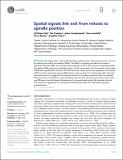| dc.contributor.author | Falk, Jill | |
| dc.contributor.author | Tsuchiya, Dai | |
| dc.contributor.author | Verdaasdonk, Jolien | |
| dc.contributor.author | Lacefield, Soni | |
| dc.contributor.author | Bloom, Kerry | |
| dc.contributor.author | Amon, Angelika B | |
| dc.date.accessioned | 2016-07-07T14:57:18Z | |
| dc.date.available | 2016-07-07T14:57:18Z | |
| dc.date.issued | 2016-05 | |
| dc.identifier.issn | 2050-084X | |
| dc.identifier.uri | http://hdl.handle.net/1721.1/103533 | |
| dc.description.abstract | In budding yeast, if the spindle becomes mispositioned, cells prevent exit from mitosis by inhibiting the mitotic exit network (MEN). The MEN is a signaling cascade that localizes to spindle pole bodies (SPBs) and activates the phosphatase Cdc14. There are two competing models that explain MEN regulation by spindle position. In the 'zone model', exit from mitosis occurs when a MEN-bearing SPB enters the bud. The 'cMT-bud neck model' posits that cytoplasmic microtubule (cMT)-bud neck interactions prevent MEN activity. Here we find that 1) eliminating cMT– bud neck interactions does not trigger exit from mitosis and 2) loss of these interactions does not precede Cdc14 activation. Furthermore, using binucleate cells, we show that exit from mitosis occurs when one SPB enters the bud despite the presence of a mispositioned spindle. We conclude that exit from mitosis is triggered by a correctly positioned spindle rather than inhibited by improper spindle position. | en_US |
| dc.description.sponsorship | Howard Hughes Medical Institute | en_US |
| dc.description.sponsorship | National Institutes of Health (U.S.) (NIH grant HD085866) | en_US |
| dc.description.sponsorship | National Institutes of Health (U.S.) (NIH grant GM105755) | en_US |
| dc.description.sponsorship | National Institutes of Health (U.S.) (NIH grant R37 GM32238) | en_US |
| dc.description.sponsorship | National Cancer Institute (U.S.) (Grant (core) P30-CA14051) | en_US |
| dc.language.iso | en_US | |
| dc.publisher | eLife Sciences Publications, Ltd. | en_US |
| dc.relation.isversionof | http://dx.doi.org/10.7554/eLife.14036 | en_US |
| dc.rights | Creative Commons Attribution 4.0 International License | en_US |
| dc.rights.uri | http://creativecommons.org/licenses/by/4.0/ | en_US |
| dc.source | eLife | en_US |
| dc.title | Spatial signals link exit from mitosis to spindle position | en_US |
| dc.type | Article | en_US |
| dc.identifier.citation | Falk, Jill Elaine, Dai Tsuchiya, Jolien Verdaasdonk, Soni Lacefield, Kerry Bloom, and Angelika Amon. “Spatial Signals Link Exit from Mitosis to Spindle Position.” eLife 5 (May 11, 2016). . | en_US |
| dc.contributor.department | Massachusetts Institute of Technology. Department of Biology | en_US |
| dc.contributor.department | Koch Institute for Integrative Cancer Research at MIT | en_US |
| dc.contributor.mitauthor | Falk, Jill | en_US |
| dc.contributor.mitauthor | Amon, Angelika B. | en_US |
| dc.relation.journal | eLife | en_US |
| dc.eprint.version | Final published version | en_US |
| dc.type.uri | http://purl.org/eprint/type/JournalArticle | en_US |
| eprint.status | http://purl.org/eprint/status/PeerReviewed | en_US |
| dspace.orderedauthors | Falk, Jill Elaine; Tsuchiya, Dai; Verdaasdonk, Jolien; Lacefield, Soni; Bloom, Kerry; Amon, Angelika | en_US |
| dspace.embargo.terms | N | en_US |
| dc.identifier.orcid | https://orcid.org/0000-0003-2910-9803 | |
| dc.identifier.orcid | https://orcid.org/0000-0001-9837-0314 | |
| mit.license | PUBLISHER_CC | en_US |
| mit.metadata.status | Complete | |
